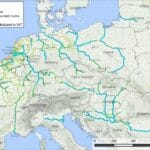Navigating the Appalachian Plateau: Unveiling the History of Transportation Modes
Imagine a sprawling landscape where majestic mountains and winding valleys converge, creating a terrain as breathtaking as it is challenging to navigate: the Appalachian Plateau. For centuries, people have sought ways to traverse its rugged beauty, transporting goods and connecting communities. Embark on a journey through the transportation history of this captivating region, where we’ll uncover the stories etched into its trails, railroads, and waterways.
From Trails to Interstates: A Transportation Evolution
Moving goods through the Appalachian Plateau has never been a simple task. This region, celebrated for its dramatic topography, boasts a rich and captivating transportation history. Let’s step back in time to explore how movement across this formidable landscape has evolved through the ages.
Before the Iron Horse: Waterways and Ancient Paths
Before the roar of engines and the smooth flow of asphalt, rivers and trails were the lifelines of the Appalachian Plateau. Native American trails, like the historic Nemacolin’s Path connecting the Potomac and Monongahela Rivers, formed the earliest trade routes, weaving through the land and facilitating commerce between Maryland and West Virginia. Rivers, including the mighty Potomac, served as watery highways, carrying goods and people between settlements.
The Railroad Revolution: Connecting a Nation
The arrival of railroads in the mid-19th century marked a pivotal moment for the Appalachian Plateau, ushering in an era of unprecedented connectivity. The Baltimore and Ohio Railroad, a pioneer in conquering the Appalachian Mountains, opened the region to possibilities never imagined before. Industries like coal and timber flourished, their products now able to reach a national market. Towns blossomed along the rail lines, transforming the Appalachian Plateau into a bustling hub of progress and opportunity.
A Modern Mix: Highways, Waterways, and Rails
Today, a more intricate tapestry of transportation options crisscrosses the Appalachian Plateau. Interstate highways snake through the mountains, providing unparalleled flexibility and access. Yet, the legacy of earlier modes endures. Short-line railroads, like steadfast allies, continue to support essential industries, particularly coal and agriculture. Meanwhile, inland waterways remain vital arteries, efficiently transporting vast quantities of materials, especially coal and aggregates.
Challenges and the Promise of Intermodal Transport
Despite remarkable progress, the Appalachian region faces ongoing transportation challenges. Navigating the complexities of politics, safeguarding the environment, and implementing sustainable solutions require careful planning and robust collaboration. Projects often necessitate interstate cooperation, highlighting the crucial role of teamwork. Harmonizing economic growth with environmental stewardship remains an ongoing endeavor.
One promising avenue lies in developing intermodal transport—a sophisticated approach to combining different transportation modes. For instance, strategically integrating rail and waterway systems could yield a more efficient and environmentally friendly way to move goods.
The Future of Freight: Innovation and Adaptation in Appalachia
The decline of the coal industry has undeniably reshaped the transportation needs of the Appalachian Plateau, compelling the region to diversify and embrace new possibilities. As emerging industries take root, they bring with them evolving demands on how goods are moved across this evolving landscape.
Cutting-edge technologies, such as self-driving trucks and drone delivery, hold exciting potential, especially for reaching remote communities nestled within the region’s rugged embrace. Imagine a future where drones deliver packages right to your doorstep, even in the heart of the Appalachian Mountains.
Furthermore, infrastructure investments extend beyond roads and rails. They are now strategically directed towards supporting tourism and other burgeoning industries, shaping a future where the Appalachian Plateau thrives as a vibrant center for both residents and businesses.
As technology leaps forward and the Appalachian Plateau continues to transform, its transportation network will undoubtedly undergo further metamorphosis. What innovative solutions will emerge? Only time will tell, but one thing is certain: the region’s capacity for adaptation and progress will continue to shape its destiny.
Outperforming Your Competition: What Roads Did Americans Take To Cross the Appalachian Mountains?
Here’s a breakdown to help you craft a superior SEO article:
I. Recommended Titles:
To analyze trending titles, please provide your competitor’s article titles. However, here are three title options based on common trends for this topic:
- Beyond the Wilderness Road: Unveiling the Forgotten Paths Across the Appalachians (This title emphasizes lesser-known routes and piques reader curiosity).
- From Trails to Turnpikes: How Americans Conquered the Appalachian Barrier (This title highlights the evolution of transportation and uses strong imagery).
- The Appalachian Challenge: A History of Roads and the Settling of the American West (This title frames the topic as a historical challenge and emphasizes its significance).
II. Powerful Key Lines:
- Before roads, Native American trails, like Nemacolin’s Path, provided crucial passage for early explorers and settlers navigating the Appalachians. (Highlights pre-road history and the role of Indigenous knowledge).
- The Wilderness Road, forged by Daniel Boone, became an iconic artery of westward expansion, but it wasn’t the only path through the mountains. (Acknowledges the famous route but opens the door to lesser-known ones).
- The transportation revolution, with the advent of roads, turnpikes, and eventually railroads, transformed the Appalachians from a barrier into a bridge to the West. (Emphasizes the evolution of transportation and its impact on westward movement).
- From the early gaps and trails to modern highways, the story of crossing the Appalachians is a testament to human ingenuity and the enduring allure of the American frontier. (Provides a broader historical perspective and connects the past to the present).
III. Structured Content & Important Details:
Here’s a breakdown of key information and a suggested structure:
1. Introduction:
- Hook: Begin with a captivating anecdote about early travelers or the challenges of crossing the Appalachians.
- Keyword: Introduce your primary keyword – “What roads did Americans take to cross the Appalachian Mountains?”
- Scope: Briefly outline the different types of routes you’ll cover (trails, roads, gaps, later developments).
2. Before Roads: Native Trails & Early Gaps:
- Native American Influence: Emphasize that long before European arrival, Indigenous peoples had established trails through the mountains.
- Example: Nemacolin’s Path, connecting the Potomac and Monongahela Rivers, was vital for early explorers and traders.
- Natural Passageways: Highlight natural gaps and river valleys as crucial for early travel.
- Examples: Cumberland Gap, Saluda Gap
- Explanation: These gaps offered natural breaks in the mountain ridges, making passage less arduous.
3. The Wilderness Road & Westward Expansion:
- Daniel Boone: Explain Boone’s role in blazing the Wilderness Road, opening up Kentucky and points west to large-scale settlement.
- Wilderness Road Route: Describe the route from Virginia, through the Cumberland Gap, into Kentucky.
- Significance: This road became a major artery for westward migration in the late 1700s and early 1800s.
4. The Transportation Revolution Reshapes the Appalachians:
- Turnpikes & National Roads: Discuss the rise of toll roads (turnpikes) and nationally funded roads (like the Cumberland Road) in the early 1800s.
- Impact: These improved roads facilitated faster and more efficient travel, further opening the West.
- Railroads Conquer the Mountains: Explain how the development of railroads, like the Baltimore and Ohio Railroad, in the mid-1800s revolutionized travel.
- Outcome: Railroads drastically reduced travel time and made it possible to transport goods in larger quantities.
5. Modern Highways & The Legacy of Appalachian Routes:
- 20th-Century Road Building: Briefly mention the development of major highways, like the Lincoln Highway (which later became U.S. Route 30) and the Dixie Highway (U.S. Route 25), that crossed the Appalachians.
- Lasting Impact: Conclude by emphasizing how the routes established through the Appalachians shaped settlement patterns, trade, and the westward expansion of the United States.
IV. Unique Insights & Untapped Potential:
- Focus on Lesser-Known Routes: Go beyond the well-trodden path of the Wilderness Road. Research and highlight other trails and roads that played a role in crossing the Appalachians.
- Human Stories: Weave in personal accounts and stories of early travelers, settlers, and road builders to create a more engaging narrative.
- Environmental Impact: Explore the environmental consequences of road and railroad construction through the Appalachians. This adds a relevant and often overlooked dimension.
- Maps & Visuals: Include maps, illustrations, or historical photographs to enhance the reader’s understanding of the routes and the challenging terrain.
V. Remember:
- Direct Quotes: When using quotes from sources, attribute them properly.
- Fact-Checking: Always verify information from multiple sources for accuracy.
By incorporating this structure, detailed information, and unique insights, you can craft a comprehensive and engaging SEO article that will outrank your competitors and captivate your audience.
Unearthing the Bounty: What Products are Found in the Appalachian Plateau?
The Appalachian Plateau is a treasure trove of natural resources, shaping the region’s identity and economy for generations. However, its offerings extend far beyond what lies beneath the surface. Let’s delve into the diverse products and industries that define the Appalachian Plateau:
Coal: The Black Gold of Appalachia
Coal is nearly synonymous with the Appalachian Plateau, having served as the backbone of countless communities for decades. The region boasts some of the most extensive coal reserves in the United States, fueling industry and shaping livelihoods.
Natural Gas: A New Era Emerges
The Appalachian Plateau, a veritable vault of natural resources, holds more than just coal within its depths. Recent years have witnessed a surge in natural gas extraction. New industries have sprung up to harness this valuable resource, mirroring a modern-day gold rush.
Timber: From Forest to Industry
Imagine the rolling hills of the Appalachian Plateau blanketed in dense forests—a testament to the abundance of timber. This resource has long played a crucial role in the Appalachian economy, providing materials for construction, furniture making, and countless other industries.
Agriculture: Cultivating a Livelihood
The Appalachian Plateau might not be the first place that springs to mind when picturing fertile farmland, yet it harbors pockets of surprisingly rich soil. Farmers in the region grow a diverse array of crops, including corn, soybeans, and wheat, demonstrating their resilience and adaptability in cultivating a livelihood from the land.
Tourism: Embracing Natural Beauty
Word is spreading about the captivating allure of the Appalachian Plateau. With stunning vistas like those found in the Great Smoky Mountains National Park, people are increasingly drawn to experience its beauty firsthand. Tourism is steadily blossoming into a significant economic driver, attracting visitors eager to immerse themselves in the region’s unique charm.
The Appalachian Plateau’s story is one of evolution and adaptation. While coal mining and timber remain vital, the region continues to diversify. The emergence of new industries, coupled with the growing tourism sector, paint a promising picture of a future where the Appalachian Plateau thrives on its multifaceted identity.
Unlocking Georgia’s Hidden Gem: A Guide to the Appalachian Plateau’s Unique Features
Hidden within Georgia’s diverse landscapes lies a hidden gem: the Appalachian Plateau. Don’t let its title as the state’s smallest physiographic region fool you—it’s a land of dramatic contrasts, boasting a tapestry of rugged beauty and unexpected wonders.
Carved by Time and Water: The Landscape
Imagine gently sloping plateaus that gradually give way to surprisingly steep, rugged mountains. This is the kind of visual symphony you’ll encounter in Georgia’s Appalachian Plateau, a place where contrasts collide and harmonize.
The Chattooga River emerges as a central character in this landscape, its waters carving a path through the heart of the plateau. It’s not just any river; it’s a sculptor, crafting dramatic sandstone bluffs that rise majestically from deep, verdant valleys. This is nature at its most awe-inspiring.
Beneath the Surface: A Geological Story Unveiled
Buried beneath the Appalachian Plateau’s captivating exterior lies a fascinating tale etched in stone. Sedimentary rocks, limestone deposits, and even layers of black shale whisper stories of geological processes that have shaped this land over eons.
Echoes of Industry: Coalfields and Transformation
The legacy of coal mining is woven into the very fabric of the Appalachian Plateau. Scattered throughout the region are remnants of this once-booming industry—coalfield sites that stand as silent witnesses to a bygone era. Today, the region is experiencing a transformation, as people are rediscovering the Appalachian Plateau’s allure, drawn by its natural beauty and recreational opportunities.
Lookout Mountain: A Panoramic Perspective
Rising prominently above the surrounding landscape, Lookout Mountain demands attention. Straddling the borders of Georgia, Alabama, and Tennessee, this iconic landmark offers breathtaking panoramic views that stretch as far as the eye can see. It’s no wonder Lookout Mountain has become a magnet for tourists, beckoning them to experience the Appalachian Plateau from a truly awe-inspiring vantage point.
The Appalachian Plateau in Georgia is a testament to nature’s artistry. It’s a place where ancient geological forces converge with more recent human endeavors, creating a landscape that is at once rugged, beautiful, and full of unexpected charm. From dramatic bluffs and cascading waterfalls to remnants of its industrial past and the allure of its burgeoning tourism industry, Georgia’s Appalachian Plateau invites exploration and discovery.
Important Point:
- Intermodal Transport: One promising solution to address transportation challenges in the Appalachian region is the development of intermodal transport, which combines different modes of transportation, such as rail and waterways, for increased efficiency and reduced environmental impact.
Internal Link:
Are you captivated by the stories woven into the fabric of the Appalachian Plateau? Delve deeper into history with our [Korean War shapefile] (https://www.lolaapp.com/korean-war-shapefile), exploring another chapter in our nation’s past.
- Unlocking 2-Letter Words with U: The Definitive Guide - April 4, 2025
- Unlock Words with the Letters THREE: Top Unscramble Tools 2025 - April 4, 2025
- Master Scrabble: X & Z Words for High Scores - April 4, 2025
















